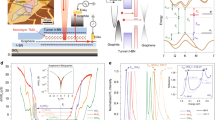Abstract
Full-potential linearized-augmented-plane-wave (FP-LAPW) calculations for δ-Pu films up to seven layers at the ground antiferromagnetic state including spin-orbit coupling effects reveal that surface energy rapidly converges and the semi-infinite surface energy is predicted to be 1.18, 1.21, and 1.42 J/m2 for δ-Pu (111), (001), and (110) films, respectively. Density of states show that the 5f electrons of the three surfaces tend to be localized with a sequence of (111)→(001)→(110). It is also predicted that the work function of δ-Pu (110) films exhibits a quantum size effect up to seven layers, while the work functions of δ-Pu (001) and (111) films show some oscillations when the number of layers is less than five, while it becomes relatively stable when the number of layers is greater than five. In addition, the work functions are predicted to be 3.41, 3.11, and 2.99 eV for δ-Pu (111), (001), and (110) films at the ground state, respectively. Comparisons with available experimental and theoretical results in the literature show good agreement.
Similar content being viewed by others
References
J. J. Katz, G. T. Seaborg, and L. R. Morss, The Chemistry of the Actinide Elements (Chapman and Hall, 1986);
L. R. Morss and J. Fuger, Eds. Transuranium Elements: A Half Century (American Chemical Society, Washington, D. C. 1992);
J. J. Katz, L. R. Morss, J. Fuger, and N. M. Edelstein, Eds. Chemistry of the Actinide and Transactinide Elements (Springer-Verlag, New York, in press);
K. K. S. Pillay and K. C. Kim, Eds. Plutonium Futures – The Science, American Institute of Physics Conference Proceedings, 532 (2000);
G. D. Jarvinen, Ed. Plutonium Futures – The Science, American Institute of Physics Conference Proceedings, 673 (2003).
S. Y. Savrasov, G. Kotliar and E. Abrahams, Nature 410, 793 (2001);
X. Dai, S. Y. Savrasov, G. Kotliar, A. Migliori, H. Ledbetter, and E. Abrahams, Science 300, 953 (2003);
J. Wong, M. Krisch, D. L. Farber, F. Occelli, A. J. Schwartz, T.-C. Chiang, M. Wall, C. Boro, and R. Xu, Science 301, 1078 (2003);
P. Söderlind and B. Sadigh, Phys. Rev. Lett. 92, 185702 (2004);
P. Söderlind, O. Eriksson, B. Johansson, and J.M. Wills, Phys. Rev. B 55, 1997 (1997);
B. Sadigh, P. Söderlind, and W. G. Wolfer, Phys. Rev. B 68, 241101(R) (2003);
S. Heathman, R. G. Haire, T. Le Bihan, A. Lindbaum, K. Litfin, Y. Meresse, and H. Libotte, Phys. Rev. Lett. 85, 2961 (2000).
A. K. Ray and J. C. Boettger, Eur. Phys. J. B 27, 429 (2002); Phys. Rev. B 70, 085418 (2004);
J. C. Boettger and A. K. Ray, Int. J. Quant. Chem., 105, 564 (2005);
X. Wu and A. K. Ray, Phys. Rev. B 72, 045115 (2005);
M. N. Huda and A. K. Ray, Eur. Phys. J. B 40, 337 (2004); Physica B 352, 5 (2004); Eur. Phys. J. B 43, 131 (2005); Physica B 366, 95 (2005); Phys. Rev. B 72, 085101 (2005); Int. J. Quant. Chem. 105, 280 (2005);
H. R. Gong and A. K. Ray, Eur. Phys. J. B, 48, 409 (2005);
D. Gao and A. K. Ray, Eur. Phys. J. B, in press.
K. Schwarz, P. Blaha, and G. K. H. Madsen, Comp. Phys. Comm. 147, 71 (2002).
J. P. Perdew, K. Burke, and M. Ernzerhof, Phys. Rev. Lett. 77, 3865 (1996).
J. G. Gay, J. R. Smith, R. Richter, F. J. Arlinghaus, and R. H. Wagoner, J. Vac. Sci. Tech. A 2, 931 (1984);
J. C. Boettger, Phys. Rev. B 49, 16798 (1994).
T. Durakiewicz, A.J. Arko, J.J. Joyce, D.P. Moore, and S. Halas, Bull. Am. Phys. Soc. 46, No. 1 (2001).
T. Gouder, L. Havela, F. Wastin, and J. Rebizant, Europhys. Lett. 55, 705 (2001);
L. Havela, T. Gouder, F. Wastin, and J. Rebizant, Phys. Rev. B 65, 235118 (2002).
A. J. Arko, J. J. Joyce, L. Morales, J. M. Wills, J. Lashley, F. Wastin, and J. Rebizant, Phys. Rev. B 62, 1773 (2000).
Author information
Authors and Affiliations
Rights and permissions
About this article
Cite this article
Gong, H.R., Asok, K.R. A First-Principles Study of the (001), (111) and (110) Surfaces of δ-Pu. MRS Online Proceedings Library 893, 8930108 (2005). https://doi.org/10.1557/PROC-0893-JJ01-08
Received:
Accepted:
Published:
DOI: https://doi.org/10.1557/PROC-0893-JJ01-08



